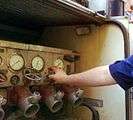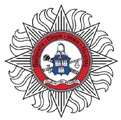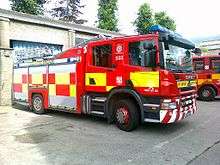Dublin Fire Brigade
| Operational area | |
|---|---|
| Country |
|
| City |
|
| Agency overview | |
| Employees | 900 |
| Chief Fire Officer | Dennis Keeley (Acting) |
| Facilities and equipment | |
| Stations | 14 |
| Engines | 21 |
| Platforms | 3 |
| Rescues | 2 |
| Ambulances | 12 |
| HAZMAT | 2 |
| Rescue boats | 2 |
| Website | |
| Official website | |
The Dublin Fire Brigade (DFB; Irish: Briogáid Dóiteáin Átha Cliath) is the local authority fire and rescue service for Dublin City and the majority of the Greater Dublin Area. It is a branch of Dublin City Council. There are currently 14 fire stations manned by DFB, 12 of which are full-time, the other 2 are part-time or "retained". Full-time stations are manned by shifts across 4 watches, A, B, C & D. There are currently over 900 active personnel making it the largest fire service based on manpower and resources in Ireland.
History
Dublin City's first municipal fire engines were delivered in 1705. Throughout the second half of the 18th Century, insurance brigades were the primary source of firefighting for the city, operating independently for buildings bearing the mark of their respective insurance companies. Eventually the brigades began to co-operate on a competition basis with the first brigade on scene being the highest paid. It wasn't until 1862 with the enactment of the Dublin Corporation Act, that the city had an organised fire brigade. Dublin man J.R. Ingram became the first superintendent of the brigade, having worked as a fireman in New York and London. The brigade consisted of 24 men with a makeshift fire brigade station on Winetavern Street in The Liberties. In 1898 the Dublin Fire Brigade Ambulance Service was established. The turn of the century saw the brigade have its first fire stations and permanent headquarters built, with the first motorised fire engine coming on stream in 1909.
Stardust fire
In the early hours of 14 February 1981, Dublin Fire Brigade received a call reporting a fire in the Stardust nightclub in Artane. Units were dispatched from both Kilbarrack fire station and North Strand fire station. When the firemen arrived they were met with scenes of panic, disorder and suffering at what would turn out be one of the worst fire disasters in the history of the state. 48 people died and 214 people were injured as a result of the fire.
Fire Stations/Appliances
| Station Callsign | Station Name | Duty System | Appliances |
|---|---|---|---|
| #1 | Donnybrook | Wholetime | 2x WtL, 1x AMB, 1x DO |
| #2 | Dolphins Barn | Wholetime | 2x WtL, 1x ET, 1x DO, 1x AMB |
| #3 | Phibsboro | Wholetime | 2x WtL, 1x WrC, 1x ET, 1x DO, 1x AMB, |
| #4 | North Strand | Wholetime | 2x WtL, 1x TRV, 1x DO, 1x AMB |
| #5 | Finglas | Wholetime | 1x WtL, 1x DO, 1x AMB |
| #6 | Kilbarrack | Wholetime | 1x WtL, 1x AMB |
| #7 | Tallaght | Wholetime | 2x WtL, 1x AMB |
| #8 | Rathfarnham | Wholetime | 1x WtL, 1x AMB |
| #9 | Blanchardstown | Wholetime | 1x WtL, 1x AMB |
| #10 | Tara Street/Pearse Street (HQ) | Wholetime | 2x WtL, 2x TL, 1x FEU, 1x ISU, 1x DO, 2x APRU, 2x AMB, 1x PCV |
| #12 | Dun Laoghaire | Wholetime | 2x WtL, 1x ALP |
| #13 | Swords | Wholetime | 1x WtL, 1x AMB |
| #23 | Balbriggan | Retained | 1x WtL |
| #24 | Skerries | Retained | 1x WtL |
| N/A | Additional Appliances* | Retained | 2x WrC, 2x RIB, 1x CIU, 1x MIU, 2x CSU, 3x PM, 1x BFU, 1x WSU, 1x HRU |
- These are appliances crewed by the DFB but kept in reserve until needed at emergencies requiring specialist equipment. They at stored at stations across the capital but are not tied down to any one in particular.
Fire Appliance Glossary/Callsigns (currently changing to longer format Oct 2018)
- Water Tender Ladder (WtL): DN11A1, DN11A2, DN12A1, DN12A2, DN13A1, DN13A2, DN14A1, DN14A2, DN15A1, DN16A1, DN17A1, DN17A2, DN18A1, DN19A1, DN21A1, DN21A2, DN22A1, DN22A2, DN23A1, DN24A1, DN25A1
- Water Carrier (WrC): D19, D39, D109
- Turntable Ladder (TL): D106, D107
- Aerial Ladder Platform (ALP): D126
- Emergency Tender (ET): D25, D35
- Tunnel Response Vehicle (TRV): D45
- Chemical Incident Unit (CIU): D113
- Command Support Unit (CSU): CS2
- Incident Command Unit (DICU)
- Incident Support Unit (ISU): D108
- Foam & Environmental Unit (FEU): D43
- Foam Support Unit (FSU): D103
- Personnel Carrier Vehicle (PCV): D108
- Inshore Rescue Boat (IrbT)
- Prime Mover + HAZMAT Response Unit (PM+HRU): D123
- Prime Mover + Water Support Unit (PM+WSU): D63
- Prime Mover (PM): D33
For Pods:
- Bulk Foam Unit (BFU)
- Major Incident Unit (MIU)
- District Officer's (DO): A, B, C, D, E, F
Emergency Ambulance Service Glossary/Callsigns
- Advance Paramedic Response Unit (APRU): EMT-A1
- Advanced Paramedic Response Unit (ARPU): EMT-A2
- Ambulance (AMB): D14, D24, D34, D44, D54, D64, D74, D84, D94, D104, D114, D134
Dublin Fire Brigade, operates 12 ambulances on behalf of the Health Service Executive and 2 advanced paramedic response vehicles with staff rotating between fire and ambulance duties. Most firefighters are PHECC registered paramedics. Fire engines are often sent to more serious medical calls before an ambulance and to assist where extra manpower is required. Dublin Fire Brigade’s fire and rescue resources are funded by and under the remit of Dublin City Council. Medical resources are funded by the HSE via service-level agreement from the National Ambulance Service annual budget.
Training centre and museum
The Dublin Fire Brigade Training Centre is located at the O'Brien Institute on the Malahide Road, Marino, Dublin 3. Recruit firefighter training as well as Paramedic training and specialised courses are held here. The centre also provides various other training courses such as fire marshal training and first aid training to private companies and individuals.[1] The Dublin Fire Brigade museum is also situated at the O'Brien Institute and can be visited by appointment.[2]
Gallery
- Dublin Fire Brigade
The Dublin Fire Brigade Training Centre at the O'Brien Institute. Dublin Fire Brigade headquarters on Townsend Street. Dolphin's Barn Fire Station (Bravo District) in Dublin 12. 
Pump bay of a Dennis RS series WrL. Thomas Street Fire Brigade Station (now part of NCAD). 
The crest of the Dublin Fire Brigade. 
A 2009 Scania Water Ladder Appliance of Dublin Fire Brigade. Dublin Fire Brigade Emergency Ambulance arriving at St. James's Hospital with a patient.
See also
References
- ↑ "Dublin Fire Brigade External Training". Dublin Fire Brigade. 2014-10-14. Retrieved 2014-10-14.
- ↑ "Dublin Fire Brigade Museum". Dublin Fire Brigade. 2014-10-14. Retrieved 2014-10-14.
External links
- Dublin Fire Brigade External Training
- Dublin Fire Brigade Museum
- Dublin Fire Brigade on Irish Fire Services resource website
- "Dublin City Fire Brigade page". Internet Archive. Archived from the original on 13 June 2011. Retrieved 9 August 2012.
- Pre Hospital Emergency Care Council